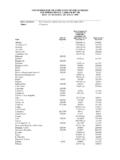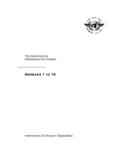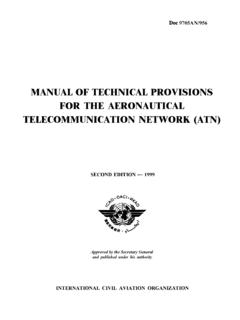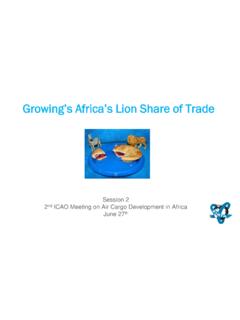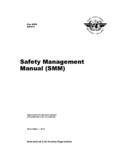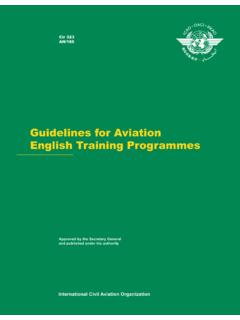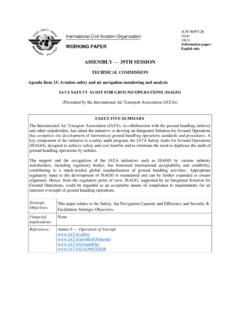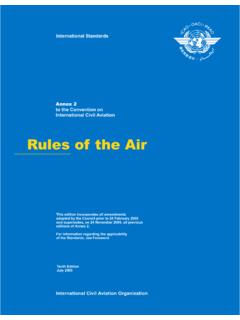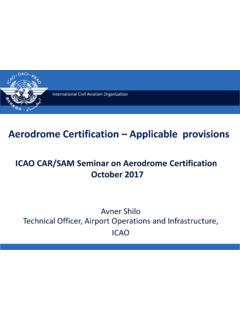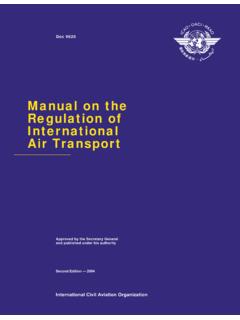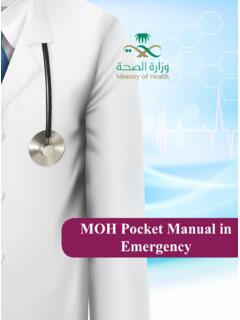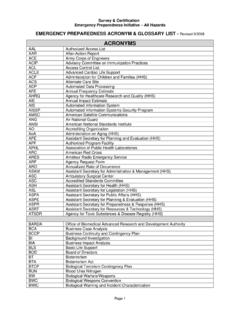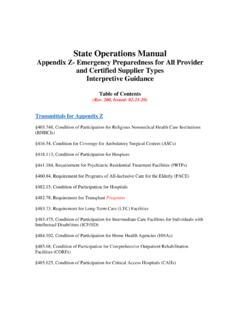Transcription of APPENDIX A GUIDANCE DOCUMENT Infectious Substances ...
1 APPENDIX A GUIDANCE DOCUMENT Infectious Substances International Civil Aviation Organization Technical Instructions for the Safe Transport of Dangerous Goods by Air, 2005-2006 Note: This GUIDANCE DOCUMENT is only valid for the period of 1 January 2005 through 31 December 2006. Introduction The 2005/2006 edition of the ICAO Technical Instructions and its Addenda (Doc 9284-AN/905 dated 18/3/05 and 30/6/05) reflect amendments made to the Infectious Substances requirements published in the 13th revised edition of the UN Model Regulations and certain requirements in the 14th revised edition. These requirements were developed in coordination with experts from the World Health Organization (WHO) and other technical experts in the field of transport, packaging and health. The purpose of this DOCUMENT is to provide GUIDANCE for complying with the 2005/2006 ICAO Technical Instructions.
2 Specifically the DOCUMENT provides GUIDANCE on: Definitions Classification Exceptions Packaging for Exempt Patient Specimens Packaging Provisions for Infectious Substances , affecting humans or animals, UN 2814 or UN 2900 Packaging Provisions for Clinical Specimens, Diagnostic Specimens, Biological Substances , Category B, UN 3373 Prohibitions Passenger Provisions Training and emergency response Definitions Infectious Substances are Substances which are known to contain, or are reasonably expected to contain, pathogens. Pathogens are defined as micro-organisms (including bacteria, viruses, rickettsiae, parasites, fungi) and other agents such as prions, which can cause disease in humans or animals. Cultures are the result of a process by which pathogens are intentionally propagated.
3 This definition does not include human or animal patient specimens. Medical or clinical wastes are wastes derived from the medical treatment of animals or humans or from bio-research - 2 - Patient specimens are those collected directly from humans or animals, including, but not limited to, excreta, secreta, blood and its components, tissue and tissue fluid swabs, and body parts being transported for purposes such as research, diagnosis, investigational activities, disease treatment and prevention. Classification For transport purposes the classification of Infectious Substances by risk groups was removed from the ICAO Technical Instructions in the 2005/ 2006 edition. Infectious Substances are now classified as Category A or Category B. There is no direct relationship between Risk Groups and Category A and B.
4 Category A Infectious Substances are Infectious Substances in a form that, when exposure to it occurs, is capable of causing permanent disability, life-threatening or fatal disease in otherwise healthy humans or animals. They are assigned the following proper shipping name and UN number: Infectious Substance affecting humans, UN 2814 or Infectious Substance affecting animals only, UN 2900. Assignments to UN 2814 or UN 2900 are to be based on the known medical history and symptoms of the source human or animal, endemic local conditions, or professional judgement concerning individual circumstances of the source human or animal. If there is any doubt as to whether or not a pathogen falls within this category it must be transported as a Category A Infectious Substance. Clinical wastes containing Category A Infectious Substances must be assigned to UN 2814 or 2900, as appropriate.
5 To assist in the assignment of an Infectious substance into Category A see the Indicative List provided in Table 2-10 in the 2005/2006 ICAO Technical Instructions and as amended in the Addendum to the ICAO Technical Instructions dated 18/3/05. That list is not exhaustive. Infectious Substances , including new or emerging pathogens, which do not appear in the table but which meet the same criteria must be assigned to Category A. Category B Infectious Substances are Infectious Substances that do not meet the criteria for inclusion in Category A. They are assigned the following proper shipping names and UN number UN 3373: Biological Substance, Category B, Diagnostic Specimen*, or Clinical Specimen*. *From January 1, 2007 the shipping names Diagnostic Specimens and Clinical Specimens will no longer be permitted.
6 Clinical wastes containing Category B Infectious Substances must be assigned to UN 3291. Further assistance on the classification of Infectious Substances can be obtained from the national health or veterinary authority. (See Annex 1 for Classification Scenarios and Annex 2 for a Classification Flowchart.) - 3 - Exceptions Substances , which do not contain Infectious Substances , or Substances , which are unlikely to cause disease in humans or animals, are not subject to the ICAO Technical Instructions unless they meet the criteria for inclusion in another class. Substances containing microorganisms which are non-pathogenic to humans or animals are not subject to the ICAO Technical Instructions unless they meet the criteria for inclusion in another class. Substances in a form that any present pathogens have been neutralized or inactivated such that they no longer pose a health risk are not subject to the ICAO Technical Instructions unless they meet the criteria for inclusion in another class.
7 Environmental samples (including food and water samples) which are not considered to pose a significant risk of infection are not subject to the ICAO Technical Instructions unless they meet the criteria for inclusion in another class. Dried blood spots, collected by applying a drop of blood onto absorbent material, or faecal occult blood screening tests and blood or blood components which have been collected for the purposes of transfusion or for the preparation of blood products to be used for transfusion or transplantation and any tissues or organs intended for use in transplantation are not subject to the ICAO Technical Instructions. Patient specimens for which there is minimal likelihood that pathogens are present are not subject to the ICAO Technical Instructions if the specimen is transported in Packaging for Exempt Patient Specimens (See below for the Packaging requirements for Exempt Patient Specimens.)
8 Note: In determining whether a patient specimen has a minimal likelihood that pathogens are present, an element of professional judgement is required. That judgement should be based on the known medical history, symptoms and individual circumstances of the source, human or animal, and endemic local conditions. Examples of specimens which may be transported as a patient specimen for which there is a minimal likelihood that pathogens are present include blood or urine tests to monitor cholesterol levels, blood glucose levels, hormone levels, or prostate specific antibodies (PSA); tests required to monitor organ function such as heart, liver or kidney function for humans or animals with non- Infectious diseases, or therapeutic drug monitoring; tests conducted for insurance or employment purposes and are intended to determine the presence of drugs or alcohol; pregnancy tests; biopsies to detect cancer; and antibody detection in humans or animals.
9 Packaging for Exempt Patient Specimens Patient specimens (human or animal) that have a minimal likelihood of containing pathogens must be packaged appropriately to further minimize the risk of exposure. While these specimens have a minimal likelihood of containing Infectious pathogens in a form that would cause infection, appropriate packaging further minimizes the risk of exposure. Effective with the publication of Addendum No. 2, dated 30/6/05, the 2005-2006 ICAO Technical Instructions require exempt human or animal specimens to be packaged and marked according to the following: (i) a leak-proof primary receptacle(s); - 4 - (ii) a leak-proof secondary packaging; and (iii) an outer packaging of adequate strength for its capacity, mass and intended use, and with at least one surface having minimum dimensions of 100 mm 100 mm; For liquids, absorbent material in sufficient quantity to absorb the entire contents must be placed between the primary receptacle(s) and the secondary packaging so that, during transport, any release or leak of a liquid substance will not reach the outer packaging and will not compromise the integrity of the cushioning material.
10 When multiple fragile primary receptacles are placed in a single secondary packaging, they must be either individually wrapped or separated to prevent contact between them. If such a packaging is used it must be marked "Exempt human specimen" or "Exempt animal specimen", as appropriate. (See Annex 3 for a graphic depiction of an Exempt Patient Specimen Packaging) If other dangerous goods are present with patient specimens the relevant provisions of the ICAO Technical Instructions apply to those goods. When dangerous goods intended for air transport are carried by surface transport to or from an airport, any other applicable national or modal transport requirements should be met in addition to those that are applicable for the goods when carried by air. Packaging Provisions for Infectious Substances , humans or animals, UN 2814 or UN 2900 Packing Instruction 602 in the 2005/2006 ICAO Technical Instructions specifies the type of packaging required for all Category A Infectious Substances .
